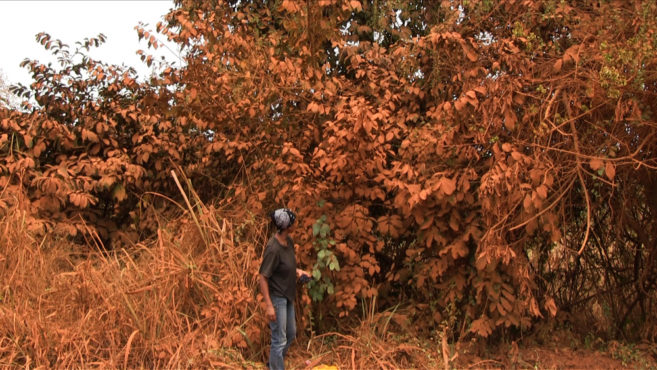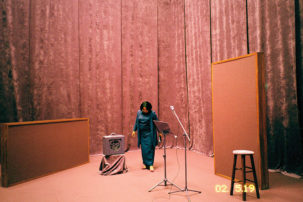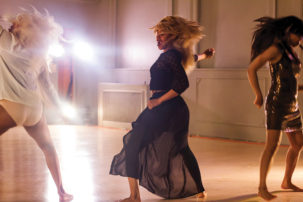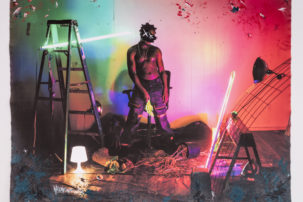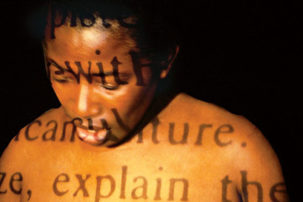An act of erasure is most violent when it becomes mundane—when it occurs so frequently that it begins to spring, nakedly, from an ugly and haunting banality. The tragedy is precisely that it’s common. It can be stiffly naturalized, like galleries devoted exclusively to the works of General Idea, or the Group of Seven: ubiquitous in the narrow Canadian art history canon. Stuart Hall calls this closure of representation “ideology,” and rightfully so: at stake is a decreed marginalization, one which renders minority groups, with all their inconvenient pain and history and cultural contributions, invisible from the historical record. Black Canadian women, for example, encounter this fate—of witnessing their own sanctioned absence—regularly when they visit Canadian museums. At these sites of remembering, which are also occasional sites of revisionism, artworks by Black Canadian women are routinely missing from gallery walls.
Prior to the opening of Mickalene Thomas’s iconoclastic “Femmes Noires” exhibition in late November, 2018, curated by the gifted Julie Crooks, the Art Gallery of Ontario had shown just one other major solo exhibition by a Black woman in its 118-year history. “Wangechi Mutu was here, what, like eight years ago? That’s a long time,” Thomas told the art critic Antwaun Sargent during a public talk on the show’s opening night. “So,” she continued, acknowledging that neither she nor Mutu is Canadian, “I think the next artist of colour here should be a Black Canadian woman. And I don’t think she should have just the fifth floor. She should have the entire museum.”
“We don’t get to see the work Black women are producing. There’s an entire perspective that’s completely absent from our visual psyche.”
Indeed, a Black Canadian woman has never had a major solo exhibition at the AGO—a museum that was formerly a wealthy white family’s patrilineal Georgian manor. “An art gallery is a modern treasure house,” wrote Canadian editor and artist Helen Kemp Frye in 1937. “Within its walls are contained associations and memories of the past well worth cherishing and works of our own time interpreting, through sensitive minds, the age in which we live.” To reflect on these observations today is to wonder, with great seriousness, exactly whose memories are “well worth cherishing,” and which works are, or aren’t, “of our own time.” Which age of Canadian history, precisely, can be said to have transpired without the presence of Black women? “There’s a plethora of artists who have been producing work since the 1960s and who that are continuously overlooked,” says Toronto-based artist and curator Anique Jordan. “It’s a huge blind spot—not just for the gallery, but for Canadian art in general—that we don’t get to see the work Black women are producing. There’s an entire perspective that’s completely absent from our visual psyche.”
It wasn’t long ago that “Black Wimmin: When and Where We Enter” (1989)—the very first Canadian exhibition featuring the work of Black women artists, organized by the Diasporic African Wimmins Art Collective (DAWA)—blazed across Canada, from Victoria to the Atlantic region, and exposed a national dereliction: How, in 1989, could this be the first exhibition of its kind? “Those women were functioning in a sort of white tundra with, really, no support,” says the interdisciplinary artist Deanna Bowen, who, even after having earned a William H. Johnson Prize in 2014 and a Guggenheim Fellowship in 2016, still struggles to attract institutional support. (In Bowen’s 25-year career, the only AGO curator to visit her studio was Michelle Jacques.) “There’s an act of devaluation of Black women’s labour in the Canadian art scene.”
 Deanna Bowen and Angela Bates in Deanna Bowen's 2017 film, We Are From Nicodemus. Courtesy the artist.
Deanna Bowen and Angela Bates in Deanna Bowen's 2017 film, We Are From Nicodemus. Courtesy the artist.
“Black Wimmin” foresaw a curatorial trend. Recent exhibitions featuring the work of Black Canadian women artists—“Black Body: Race, Resistance, Response” at the Dalhousie Art Gallery in 2001; “Every. Now. Then: Reframing Nationhood” at the AGO in 2017; and “Here We Are Here: Black Canadian Contemporary Art” at the Royal Ontario Museum in 2018—were organized largely by Black women curators. So the custodial work of cultivating space for Black Canadian women artists, of doing the necessary outreach and systemic adjustment and—so to speak—of cleaning up the mess, continues to fall on the shoulders of those who have been historically effaced. “Why is Julie Crooks the only person in that institution who has been tasked with broaching the conversation?” says Bowen. Black women curators, like Black women artists across the country, are absurdly and perpetually saddled with the Sisyphean labours of memory. Meanwhile, white curators, who make up the better part of most Canadian museums, maintain their narrow focus and, by extension, their discriminating taste for whiteness.
Failing to initially extend these artists such opportunities bars them from attaining the profile larger institutions seek out.
Statistics, too, describe an institutional failure to affirm the worth of art produced by Black women. Two online studies commissioned by Canadian Art confirm how Black women artists have been overlooked: In 2015, it was reported that white men disproportionately make up solo gallery shows across the country; two years later, another study found that directorial and curatorial positions were also inordinately held by white people. Yet in the 30 years since “Black Wimmin,” many talented Black women artists have emerged: Oreka James’s paintings evoke the dissociative and psychological tolls of racism; Tau Lewis’s resin body-casts are a study of Black identity, diaspora and her own environment; Esmaa Mohamoud’s sculptures critique the violence of masculinity and the revisionism of Canadian history. Still, Black Canadian women artists are rare within the national gallery system.
“Mickalene Thomas’s exhibition both speaks back to ‘Black Wimmin’ and continues the conversation about representation and a critique about the white male Western art historical tradition,” says Crooks. “It represents a great moment and opportunity for reflection at the AGO, which, like most cultural institutions, comes out of that limited Western tradition.”
This widespread tradition, and its problem of diversity—or lack thereof—is upheld in the Hollywood film industry as much as it is in the art world. There, the refrain goes that there simply aren’t enough BIPOC A-list actors to carry an audience into a theatre. In the art world, the exclusion of Black Canadian women—from permanent collections, from solo exhibitions—is often summarized as the natural result of a dearth or lack of prestige. Mickalene Thomas is shown in place of a Canadian artist because, supposedly, there are none who possess her prowess or stature. Yet this logic is lopsided: lack of access to space is where this erasure begins. How can the artist have a profile if, at each level of the institution, she is denied the opportunity to show her work? Failing to initially extend these artists such opportunities bars them from attaining the profile larger institutions seek out. Black women artists aren’t nurtured by Canadian art institutions through the different stages of their careers; in turn, they are told they aren’t elite enough to be collected. The problem is structural, and, for both Black Canadian women artists and museumgoers, leaves much to be desired.
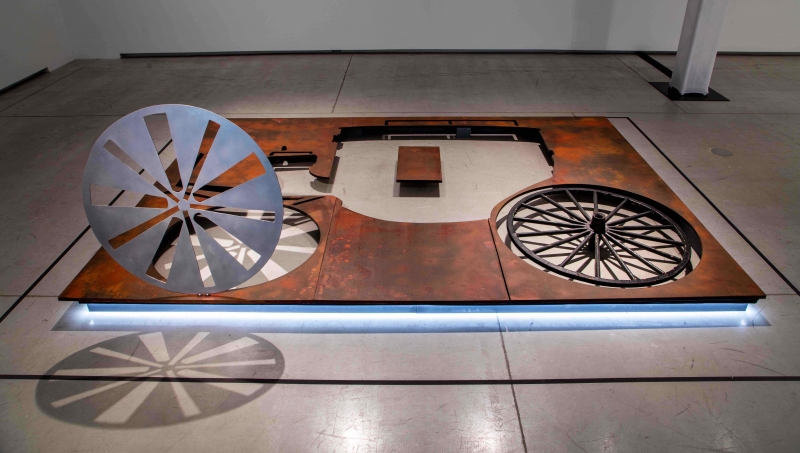 Charmaine Lurch, Blueprint for a Mobile and Visible Carriage, installation, dimensions variable. Installation view from “Every. Now. Then: Reframing Nationhood.” Photo: Dean Tomlinson © 2017 Art Gallery of Ontario.
Charmaine Lurch, Blueprint for a Mobile and Visible Carriage, installation, dimensions variable. Installation view from “Every. Now. Then: Reframing Nationhood.” Photo: Dean Tomlinson © 2017 Art Gallery of Ontario.
“Why do white men get to have their own solo exhibitions? What makes their work more important?” says Antwaun Sargent. “When you’re giving someone an entire museum floor, what you’re saying is that this work matters, right? What you’re saying is work deserves more of your attention than, maybe, a single painting on a single wall, or than a single photograph, or single sculpture.” Embedded in the act of curation—a form of memory work—is a declaration of value. As elite cultural institutions, museums tell us what is high art and culture, what is worthy or important enough for us to see. To be overlooked is to be told you don’t matter—that your work is not good enough, that your concerns are unimportant.
Black women rarely enter the gallery as part of the permanent collection, or as solo-exhibiting artists. More frequently they are brought in as moving parts—briefly supported and then released.
This isn’t to say the AGO has made no strides in addressing its flailing white solipsism, or even that it is alone in its dilemma. In late December, a small show of works by the Afrocentric artist Winsom, curated by Andrea Fatona, opened at the J.S. McLean Centre for Indigenous and Canadian Art. Later this month, the AGO will host “The Feast,” a performative dining experience organized by Black Wimmin Artist (a virtual collective of Black women arts workers, founded by Anique Jordan), which will invite over 100 Black women artists and arts workers into the museum. Many Canadian museums consult Black artists on how to reverse the paucity of Black museumgoers, or host symposiums and public discussions headed by Black women. These inchings toward progress, though, are often fleeting. Sandra Brewster and Seika Boye, both Black Canadian women, were artists in residence at the AGO last year. But such appointments are palliative and brief, and illustrate the limitations around how Black women can enter the gallery: rarely as part of the permanent collection or as solo-exhibiting artists, and more frequently as moving parts, briefly supported and then released.
The rapturous impulses of Mickalene Thomas’s work are, unfortunately, interrupted by their colonial environs. “Mickalene has concerns of Black life, around Black womanhood, that are different from Wangechi’s concerns, or that are different from Carrie Mae Weems’s concerns, or that are different from Tsachabalala Self’s concerns,” Sargent says. “It’s not enough to just get a Black woman and to say she is representative of all concerns…What might these positions look like from a historical context that is actually rooted in the country where the museum is?” In some ways, “Femmes Noires,” in place of a Black Canadian art exhibition, allows the institution to outsource Blackness—and all the ugly things it rubs up against—to the United States, continuing a narrative which positions racism as a languishing story to be addressed outside domestic borders.
Still, there is some irony folded into “Femmes Noires.” Thomas’s works, particularly her stylized portraits of Black women, are quite literally larger than life. They subvert the gaze of a white-boy network and draft a new one. At her talk, Thomas joked that she loved googling Édouard Manet’s Le Déjeuner sur l’herbe, the iconic 1863 oil painting, and finding her own images appear in the results. Just as she corrects the historical erasure of Black women from the Western art historical canon in a Canadian context, the AGO, itself, maintains it. The museum’s gesture is real, but it is also self-deprecating. “This is about Black history. The Black women artists who I know are all actively making Black Canadian history,” says Bowen. “And that, too, needs to be brought forward.”
This article was corrected on January 11, 2019. The original stated that “Black Wimmin: When and Where We Enter” (1989) was organized by artists Buseje Bailey and Grace Channer, not the Diasporic African Wimmins Art Collective (DAWA). On January 8, 2020, this article was corrected to reflect that, at the time of publication, the Art Gallery of Ontario had shown just two major solo exhibitions by Black women in its 118-year history.

 Mickalene Thomas, Los Angelitos Negros, 2016. Four HD video monitors: four two-channel HD videos, sound. 121.9 x 137.2 cm, 23 minutes, 18 seconds. 121.9 x 137.2 cm. Courtesy of the artist. © Mickalene Thomas / SOCAN (2018).
Mickalene Thomas, Los Angelitos Negros, 2016. Four HD video monitors: four two-channel HD videos, sound. 121.9 x 137.2 cm, 23 minutes, 18 seconds. 121.9 x 137.2 cm. Courtesy of the artist. © Mickalene Thomas / SOCAN (2018).
